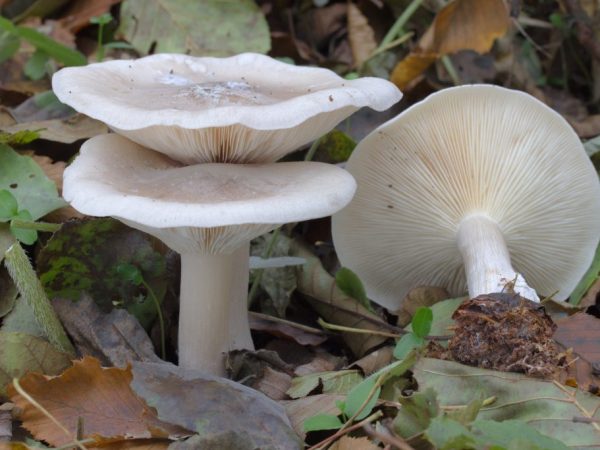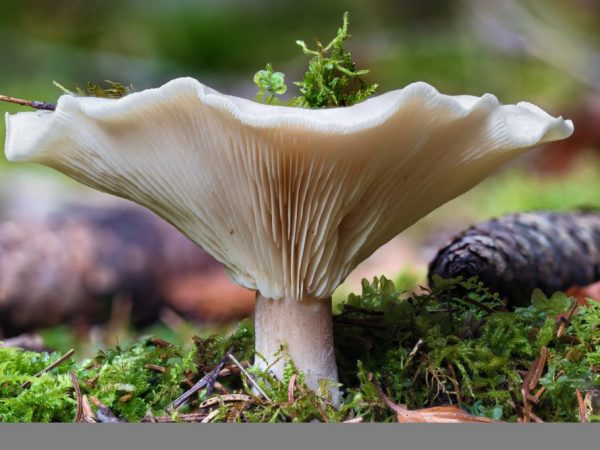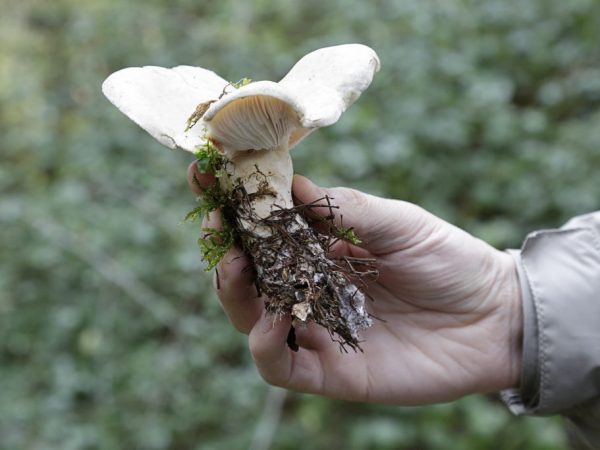Description of the talker mushroom
The talker mushroom has a large number of varieties. Among them there are both edible mushrooms with a pleasant taste and dangerous poisonous representatives that can cause severe poisoning.

Description of the talker mushroom
Description of the mushroom
Representatives of talkers have a small hat, which only in rare cases is of medium size, its diameter ranges from 3 to 6 cm, and 10-15 cm in some species. All young mushrooms have a hemispherical upper part (cap), which over time levels out and becomes depressed, funnel-shaped. The color ranges from grayish to gray-brown, pinkish, brown and ocher. In the center is a circle that is darker in color than the rest of the hat. On the surface of the cap, you can sometimes notice the remains of mycelium, which resembles mold. The hymenophore is white or cream-colored. The plates forming it are located close to each other, initially white, but as the fungus ages, they can acquire a yellowish tint.
According to the description, the shape of the leg depends on the species, its height reaches 8 cm in height, and the diameter is from 0.5 to 3 cm.The white dense pulp becomes yellowish over time and acquires a loose structure. These are autumn mushrooms, whose peak fruiting occurs in August-September, but some species grow in frosts, such as, for example, the winter talker.
Irina Selyutina (Biologist):
Talkers are the most numerous genus of cap mushrooms that are part of the Ryadovkovye family, or Tricholomovye. This genus unites about 250 species and among them there are both edible and poisonous species, including deadly ones, so they are usually collected only by experienced mushroom pickers. ). Their usual neighbors are considered to be a purple ryadovka and a blushing umbrella.
Talkers are mycorrhizal fungi. They enter into symbiotic relationships more often with representatives of deciduous tree species.
On the territory of Russia there are about 60 types of talkers. They can be found in the forests of the temperate climatic zone of the European part of the Russian Federation, Siberia and the Primorsky Territory.

The talker has a small hat, its diameter is from 3 to 6 cm
Mushroom species
There are more than 250 species of these mushrooms, only about 1/4 of them have been studied in our country.
Mace-footed talker
The species belongs to edible mushrooms and is characterized by low taste. The diameter of the cap is 4-8 cm, at the beginning of growth, its shape is convex, and then gradually becomes prostrate, sometimes forming a funnel. The color ranges from grayish to brown. The edges of the cap are always much lighter than the main part of the cap. The hat is hygrophilous. The pulp is friable, watery after rains, can have a pronounced sweet smell.The plates of the hymenophore are white and, as they grow, become creamy, densely located on the pedicle.
The leg reaches 3-9 cm in height, looks like a club with a wide base (but not bulging!). The color is either light gray or dark. The entire surface of the leg is smooth. The diameter of the thinnest point does not exceed 0.5 cm. The flesh of the leg is also loose and fibrous. The clubfoot talker forms clusters of fruiting bodies of different ages.
For your information. Today this type of mushroom belongs to the Gigroforovye family.
Funnel talker, or funnel
The funnel talker is also called the fragrant talker, or the fragrant talker. The cap reaches 8 cm in diameter, its edges are tucked inward and after a while it takes on a goblet shape. The color is gray-yellow, brown or fawn. The pulp is not thick, white, dry and has a characteristic odor. The plates on the leg of this type of talker are often located, have a white color. The length of the leg reaches 3-7 cm, and reaches up to 1 cm in diameter, the base is thickened, it itself has a fibrous structure, its color is similar to the cap, or slightly lighter than the latter. The lower part of the leg is covered with a fine white or whitish downy.

The talker mushroom has more than 250 species
The funnel-talker prefers to grow in groups, the favorite habitat is deciduous litter, and it is also often found near roads.
This type is edible, belongs to the 4th category and requires preliminary boiling. Only young representatives are eaten, but even they do not differ in good taste.
Fruiting begins in July and lasts until the end of September; the funnel-shaped talker lives in deciduous forests. During this period, the purple ryadovka also grows nearby.
Giant talker
The giant talker is a conditionally edible lamellar mushroom. Its cap reaches 10 to 30 cm in diameter, has a weakly pronounced funnel shape and wavy edges. Under the whitish or cream-colored cap, there are descending plates that are tightly located to each other. As they get closer to the stem, they become darker. The pulp is quite tight, does not have a pronounced taste and gives off a mealy odor. The leg of the giant talker is smooth, reaches 4-7 cm in diameter, has a cylindrical shape, slightly tapers towards the base. Its color matches the color of the cap.
The giant talker mushroom bears fruit from August to October, but if the weather is sunny outside, then it is harvested in November. They can be found in clearings in coniferous and mixed forests. Before eating, it is imperative to process them thermally (boil for 15-20 minutes).
In the body of the giant talker, there is a natural antibiotic clitocybin A and B, which can destroy the tubercle bacillus.
By the way. Despite its specific name, the giant talker does not belong to the Govorushka genus, but to the Svinukha genus (do not confuse with pigs). But this genus still belongs to the Ryadovkovy family.
Bent talker
The bent talker, or the red talker, is another representative of this family. It belongs to the 4th category and is conditionally edible, which means: before eating, preliminary heat treatment is required. The water in which the mushroom was boiled is drained, it is not suitable for further use, and even more so it is not suitable as a base for mushroom broth. The hat of this type reaches 20 cm in diameter, it itself is smooth, with a tubercle in the center. In young representatives, it is convex, and as it grows, it acquires a funnel-shaped shape. Its color ranges from red to dull beige. Its color in old mushrooms can fade, and sometimes rusty spots appear on the surface. The hymenophore is white. The flesh of the cap is dense, white in color, pleasant to the taste and has a persistent aroma.Plates of a similar white color, thin, in old mushrooms can acquire a creamy shade.
The leg is cylindrical in shape, its height is up to 15 cm, and the diameter is up to 2-3 cm. In young mushrooms, it is light yellow, but over time its color becomes the same as that of the cap. The flesh of the folded-up govorushka leg is dense and white. Subsequently, it becomes loose and brown. Unlike the cap, it has a pungent taste and smell.
Red-haired talkers prefer to grow up in groups, which allows them to quickly fill the basket. The harvesting season for these mushrooms occurs in early July and lasts until the end of October. Collect only the caps of young specimens. Boil for 20 minutes before use.
Orange talker
Orange talker, or false chanterelle refers to conditionally edible mushrooms. It has a cap up to 5 cm in diameter, which is characterized by edges bent inward, a prostrate shape, which becomes funnel-shaped over time. Descending plates, when pressed, acquire a brown color. This mushroom is also called a false chanterelle, tk. outwardly, he really looks like a chanterelle. It is distinguished by its brighter orange color, dense pulp and the presence of a clear border between the lamellar hymenophore and the leg.
Pale talker
Mushroom pickers also call her weakly colored talker. The description indicates that the pale-colored govorushka is an inedible mushroom of the Ryadovkovye family. It has a small cap up to 5 cm in diameter with a pronounced dark center. In young mushrooms, the edges are bent and become jagged over time, while the cap itself initially has a convex shape, which becomes funnel-shaped with age. The color of the fungus changes depending on the weather, in dry season it is grayish, and during rains it is grayish-ash with brown tints. The length of the leg is 3-6 cm, the diameter is not more than 1 cm. Its base is dark, it itself is covered with white powder, has a clavate shape, which is replaced by a cylindrical one. The pulp does not have a pronounced smell and taste.
Representatives of this species prefer deciduous forests for their habitat. In assessing the edibility, the opinions of experts were divided - some consider this mushroom inedible, and some - poisonous.

Pale-colored talker - an inedible mushroom of the Ryadovkovye family
Whitewashed talker
A whitish talker, or a whitewashed talker belongs to inedible representatives, it is more dangerous than representatives of the Amanita clan. It contains a large percentage of muscarine. Outwardly, it looks like milk mushrooms, so mushroom pickers should be especially careful when picking mushrooms. The use of this mushroom in food causes severe poisoning, a decrease in pressure, breathing disorders, vomiting, diarrhea, and a slowing of the heart rate. The lethal outcome in most cases can be avoided, but the consequences are difficult to eliminate. The cap reaches 2-6 cm in diameter, in young representatives it is convex in shape with folded edges, as it grows, it becomes prostrate, and the edges acquire a wavy appearance.
The hat is white, in rare cases grayish. A light bloom of a matte color is noticeable. The hat is hygrophilous, i.e. when it rains, it is able to retain water inside itself. The pulp is not fleshy, with many fibers, a mealy odor and a mild taste. The stem grows up to 4 cm in height and up to 0.6 cm in diameter, has a cylindrical shape with a characteristic narrowing at the base. It comes in white or gray shades, like the hat. Brown spots are visible on its surface. The hymenophore is lamellar, also white. Grows in large groups. It bears fruit from mid-summer to late autumn.
The talker is reddish
The type of govorushka is reddish, or the govorushka is furrowed, also called a whitish govorushka (bleached, or discolored), it differs from it in a short leg and a pinkish skin color. The rest of the description is identical.Although previously they were differentiated and considered different species, scientists came to the conclusion that this is one polymorphic species, because they have a similar molecular genetic structure. The reddish talker grows in deciduous, mixed forests. It can also be found in meadows, pastures or parks.
Leaf-loving talker
A leaf-loving talker, like a translucent talker, is a poisonous mushroom. She is also called the waxy talker. The hat grows up to 10 cm in diameter, has a convex shape with open wavy edges. The leg is up to 3 cm in height and up to 1.5 cm in diameter, cylindrical in shape, with a slightly thickened base. The waxy govorushka is similar to the pendant, which is edible. Many inexperienced mushroom pickers often confuse them with each other, which leads to severe poisoning due to the presence of a high concentration of muscarine in its pulp. Grows in all types of forests on a litter of decaying foliage or needles. It grows almost always in groups that form paths or circles.
Red & brown talker
Inverted talker - this is its second name, refers to inedible species according to some sources, and according to others, the mushroom is poisonous due to the presence of muscarinic compounds in its fruiting body. The cap grows up to 8 cm in the form of a deep funnel, with a reddish tint prevailing in its color. The lamellar hymenophore is initially white, but as the fungus ages, it becomes dark orange or pink-brown in color. The leg is small (up to 6 cm in height) and up to 1 cm in diameter. The mushroom has a pleasant taste and aroma. The flesh of the representative is dense.
Beneficial features
Talker mushrooms have a lot of useful properties. They are low in calories, this is important for those who monitor their diet and want to keep their weight normal. They contain a lot of fiber, minerals, macro- and microelements.
Irina Selyutina (Biologist):
In the pharmaceutical industry, talkers are so-called. "Primary raw material", which is used to obtain several types of antibiotics, including clitocybin. This drug is very important for the suppression of the activity of the tubercle bacillus and the treatment of epilepsy. The fruiting bodies of talkers also contain nebularin, an antimicrobial substance, which in its action resembles the antibiotic clithocybin, but at the same time it is less active and does not give the development of side effects.
The water extract acts practically in the same way as the antibiotics known to us (levomycin, biomycin, streptomycin) on the wound microflora.
Eating them in food helps to improve digestion, strengthen the immune system. They prevent the formation of inflammatory processes and are a natural antibiotic. The systematic addition of them to food helps to improve memory, increase concentration. Also, edible types of talkers, with regular use, can remove cholesterol plaques from blood vessels.
Contraindications
Edible species are not harmful, but they have a number of contraindications, in the presence of which you should not eat them. These include:
- pregnancy;
- lactation period;
- the presence of diarrhea;
- irritable bowel syndrome;
- indigestion and stomach acidity.
Talker mushrooms should not be given to children at an early age, because the active ingredients contained in their composition can cause bouts of nausea and vomiting.

Edible species have some contraindications
Application
The presence of a huge number of various representatives of this species has led to their widespread use in the economy and medicine.
In cooking
Talker mushrooms have a special taste, and their smell gives off fruity notes, but they are not very popular at the same time. Young mushrooms are used for cooking, because in old age they lose their taste. Only the hats are taken, the legs are not used at all. This mushroom is suitable for all types of homemade dishes and preparations.They perfectly complement soups and are often used as a base for sauces. The main thing to remember is that representatives of this genus are conditionally edible mushrooms and they need preliminary heat treatment before further use. Mushrooms have a fibrous structure and, when boiled, lose more than half of their weight, this should also be taken into account when cooking. In numbers, this can be expressed as a 5: 1 ratio, where the first number is what was before cooking, and the second is what is left after it. Only the smoky govorushka (gray) is dried and salted.
In medicine
In official medicine, this type is not widely used, because its representatives have not been fully studied, but traditional healers have long noticed the beneficial properties of this mushroom and began to use it for their own purposes. Talker mushrooms are used to make various decoctions and ointments that help disinfect wounds. Extracts from them are drunk for urolithiasis and pneumonia.
Conclusion
In the genus Govorushka, there are a huge number of both tasty edible species and representatives that are more dangerous than the red toadstool (fly agaric). The main thing is to always be careful when harvesting and carry out preliminary heat treatment before eating mushrooms.



